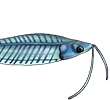Geerincx, T & D Adriaens, 2006. The erectile cheek-spine apparatus in the bristlenose catfish Ancistrus (Loricariidae, Siluriformes), and its relation to the formation of a secondary skull roof. Zoology 109: 287â??299.
Abstract
In the South American catfish family Loricariidae, the opercle has been decoupled from the lower jaw, and has also lost its function in expiration. While many loricariid species have a small and slightly mobile opercle with reduced opercular musculature, within the hypostomine subfamily a novel opercular mechanism has developed that erects a tuft of enlarged odontodes anterior to the opercle. This defensive mechanism is examined in Ancistrus cf. triradiatus. The opercle has a prominent anterior process and the orientation of the reinforced articulation hinge to the hyomandibular bone has shifted. The opercular musculature is well developed, with a hypertrophied dilatator operculi that extends deep inside the skull roof bones and toward the midline, over the brain, but below the superficial skull roof. Hence the frontal, sphenotic, parieto-supraoccipital and compound pterotic bones consist of a dorsal, superficial part and a deeper part separating the brain from the muscle: two functional skull roofs are thus formed. The impact on the path of the cranial sensory canals is substantial, moving canals away from the skull surface. Hypertrophy of cranial muscles is known from many teleosts, but the invasion of such large muscles into the skull, which is drastically modified and literally hollowed out, has never been described before. These cranial modifications are greater in males than in females, related to the territorial behavior of the former, in which the erectile spines are usually used.
Erectile cheek spines in Ancistrus
- Silurus
- Posts: 12420
- Joined: 31 Dec 2002, 11:35
- I've donated: $12.00!
- My articles: 55
- My images: 893
- My catfish: 1
- My cats species list: 90 (i:1, k:0)
- Spotted: 424
- Location 1: Singapore
- Location 2: Moderator Emeritus





